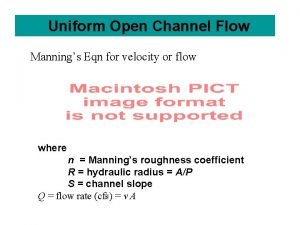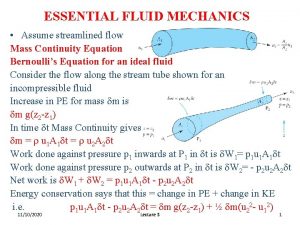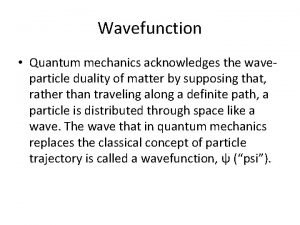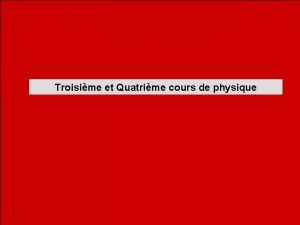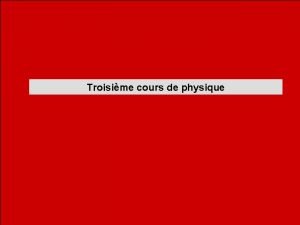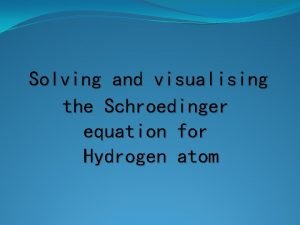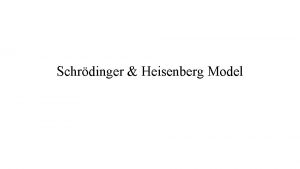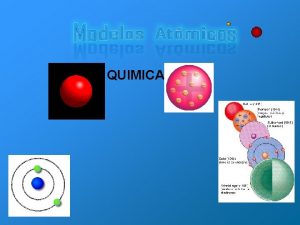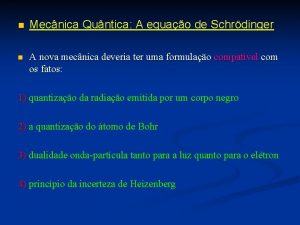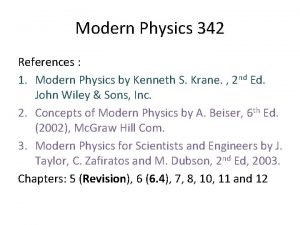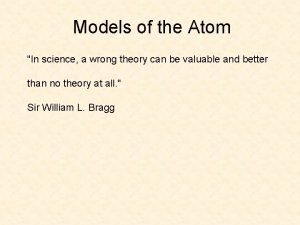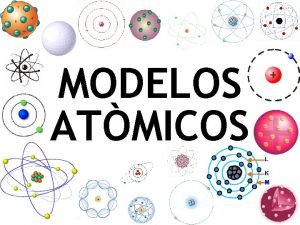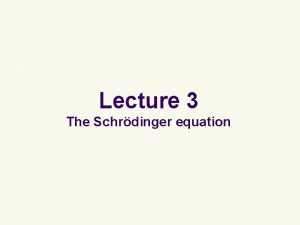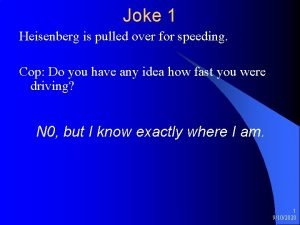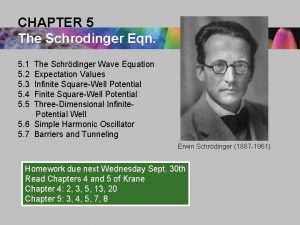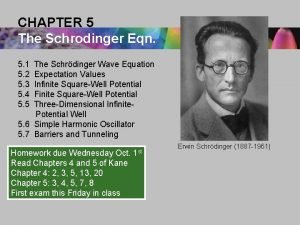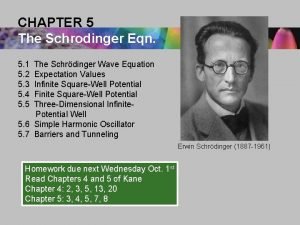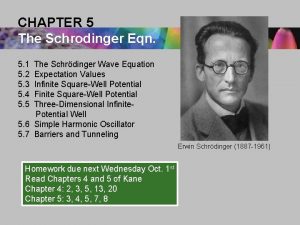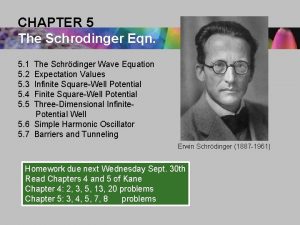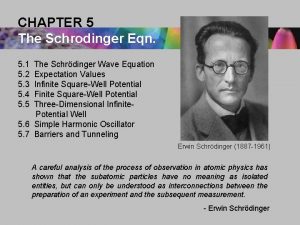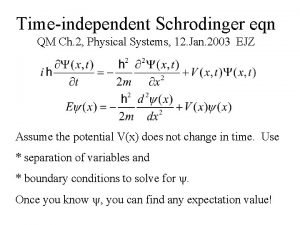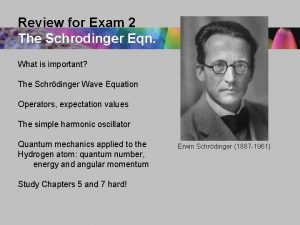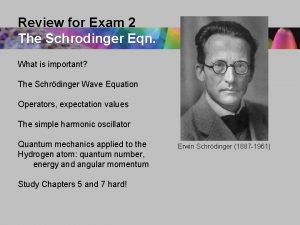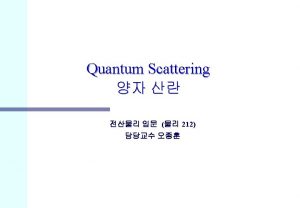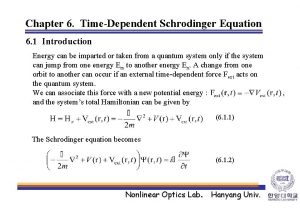CHAPTER 5 The Schrodinger Eqn 5 1 5














- Slides: 14

CHAPTER 5 The Schrodinger Eqn. 5. 1 5. 2 5. 3 5. 4 5. 5 The Schrödinger Wave Equation Expectation Values Infinite Square-Well Potential Finite Square-Well Potential Three-Dimensional Infinite. Potential Well 5. 6 Simple Harmonic Oscillator 5. 7 Barriers and Tunneling Erwin Schrödinger (1887 -1961) A careful analysis of the process of observation in atomic physics has shown that the subatomic particles have no meaning as isolated entities, but can only be understood as interconnections between the preparation of an experiment and the subsequent measurement. - Erwin Schrödinger

Opinions on quantum mechanics I think it is safe to say that no one understands quantum mechanics. Do not keep saying to yourself, if you can possibly avoid it, “But how can it be like that? ” because you will get “down the drain” into a blind alley from which nobody has yet escaped. Nobody knows how it can be like that. - Richard Feynman Those who are not shocked when they first come across quantum mechanics cannot possibly have understood it. Richard Feynman (1918 -1988) - Niels Bohr

Particle in a Box A particle (wave) of mass m is in a one-dimensional box of width ℓ. The box puts boundary conditions on the wave. The wave function must be zero at the walls of the box and on the outside. In order for the probability to vanish at the walls, we must have an integral number of half wavelengths in the box: The energy: The possible wavelengths are quantized and hence so are the energies:

Probability of the particle vs. position Note that E 0 = 0 is not a possible energy level. The concept of energy levels has surfaced in a natural way by using waves. The probability of observing the particle between x and x + dx in each state is:

Properties of Valid Wave Functions Conditions on the wave function: 1. In order to avoid infinite probabilities, the wave function must be finite everywhere. 2. The wave function must be single valued. 3. The wave function must be twice differentiable. This means that it and its derivative must be continuous. (An exception to this rule occurs when V is infinite. ) 4. In order to normalize a wave function, it must approach zero as x approaches infinity. Solutions that do not satisfy these properties do not generally correspond to physically realizable circumstances.

Normalization and Probability The probability P(x) dx of a particle being between x and x + dx is given in the equation The probability of the particle being between x 1 and x 2 is given by The wave function must also be normalized so that the probability of the particle being somewhere on the x axis is 1.

Expectation Values In quantum mechanics, we’ll compute expectation values. The expectation value, , is the weighted average of a given quantity. In general, the expected value of x is: If there an infinite number of possibilities, and x is continuous: Quantum-mechanically: And the expectation of some function of x, g(x):

Bra-Ket Notation This expression is so important that physicists have a special notation for it. The entire expression is called a bracket. And is called the bra with The normalization condition is then: the ket.

The Schrödinger Wave Equation for the wave function Y(x, t) for a particle in a potential V(x, t) in one dimension is: where The Schrodinger Equation is the fundamental equation of Quantum Mechanics. Note that it’s very different from the classical wave equation. But, except for its inherent complexity (the i), it will have similar solutions.

General Solution of the Schrödinger Wave Equation when V = 0 Try the usual solution: This works as long as: which says that the total energy is the kinetic energy.

General Solution of the Schrödinger Wave Equation when V = 0 In free space (with V = 0), the wave function is: which is a sine wave moving in the x direction. Notice that, unlike classical waves, we are not taking the real part of this function. Y is, in fact, complex. In general, the wave function is complex. But the physically measurable quantities must be real. These include the probability, position, momentum, and energy.

Time-Independent Schrödinger Wave Equation The potential in many cases will not depend explicitly on time: V = V(x). The Schrödinger equation’s dependence on time and position can then be separated. Let: And substitute into: which yields: Now divide by y(x) f(t): The left side depends only on t, and the right side depends only on x. So each side must be equal to a constant. The time-dependent side is:

Time-Independent Schrödinger Wave Equation Multiply both sides by f /iħ: which is an easy differential equation to solve: But recall our solution for the free particle: in which f(t) = exp(-iwt), so: w = B / ħ or B = ħw, which means that: B = E ! So multiplying by y(x), the spatial Schrödinger equation becomes:

Stationary States The wave function can now be written as: The probability density becomes: The probability distribution is constant in time. This is a standing-wave phenomenon and is called a stationary state. Most important quantum-mechanical problems will have stationary-state solutions. Always look for them first.
 Flow profile in open channel
Flow profile in open channel Continuity eqn
Continuity eqn Eigenfunction
Eigenfunction Equation de schrodinger
Equation de schrodinger Equation de schrodinger stationnaire
Equation de schrodinger stationnaire Solving schrodinger equation for hydrogen atom
Solving schrodinger equation for hydrogen atom Persamaan schrodinger
Persamaan schrodinger S bohr model
S bohr model Modelo de dalton mg
Modelo de dalton mg Equação de schrodinger
Equação de schrodinger Schrodinger hypothesis
Schrodinger hypothesis Quantum mechanical atomic model
Quantum mechanical atomic model Modelo del atomo actual
Modelo del atomo actual Kinetic energy operator
Kinetic energy operator Jokes
Jokes
